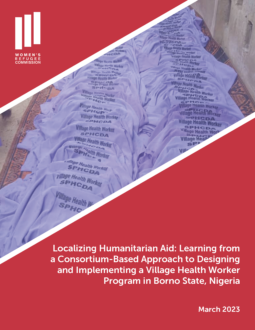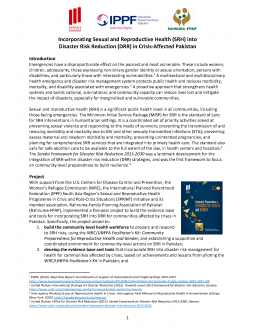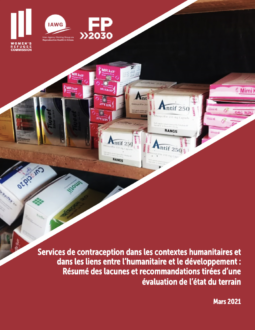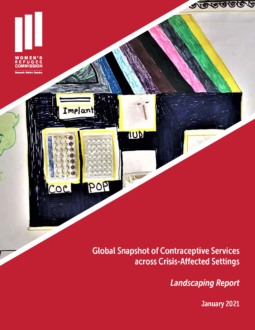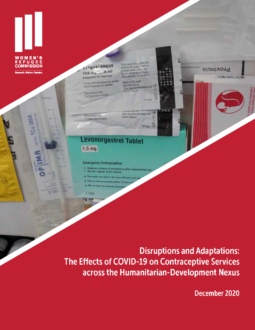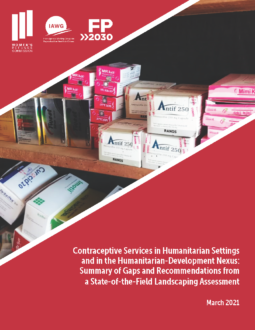
Contraceptive Services in Humanitarian Settings and in the Humanitarian-Development Nexus
PublishedThe Women’s Refugee Commission completed a landscaping assessment from 2018–2020 to evaluate and build the evidence base on barriers, opportunities, and effective strategies to provide contraceptive services to women and girls affected by crises. Despite some progress made toward making contraceptives available in humanitarian settings, contraceptive service provision continues to be a gap in humanitarian health funding and programming, even as humanitarian needs are climbing at an unprecedented pace. This inattention undercuts the efficacy of humanitarian assistance and does a significant disservice to crisis-affected individuals.
Contraception is lifesaving and a priority health service in emergencies. The 2018 Minimum Initial Services Package (MISP) for sexual and reproductive health (SRH), the global standard for SRH response in acute emergencies, includes prevention of unintended pregnancies as one of six objectives. Contraception should be made available along with other essential SRH services at the outset of every emergency response, including epidemics and pandemics, and should be scaled up further after the acute stage of an emergency.
The assessment findings reinforce the importance of conducting ongoing advocacy and mobilization with governments, donors, and implementing agencies across the humanitarian development continuum to prioritize contraception as part of SRH in humanitarian settings, from preparedness to response to recovery, recognizing that contraception is lifesaving and part of the standard of care in emergencies. Specifically, they must improve access to the full method mix, including long-acting reversible contraceptives and emergency contraception; address barriers for adolescents and marginalized populations to meet their clear demand for contraception; improve data collection and use; and strengthen supply chains to improve contraceptive commodity security. To address these gaps, stakeholders must collectively strengthen preparedness for SRH to mitigate the impact of crises and invest in local partners to foster effective, efficient SRH response and support sustainable recovery. Finally, it is critical to continue building the evidence base on effective contraceptive programming.
The assessment included a literature review, a global contraceptive programming survey, case studies in three humanitarian settings, and two sets of key informant interviews (KIIs). The second set of KIIs was conducted after the COVID-19 pandemic began and aimed specifically to understand the effects of COVID-19 on contraceptive services. All other assessment components were completed before the start of the pandemic.
Two-Page Summary of Findings and Recommendations
Contraceptive Services in Humanitarian Settings and in the Humanitarian-Development Nexus, including during the COVID-19 Pandemic – Report Summary
Full Report
Summary
Full Report
Contraceptive Services in Humanitarian Settings and in the Humanitarian-Development Nexus: Summary of Gaps and Recommendations from a State-of-the-Field Landscaping Assessment
Related Resources
- Recommendations to Strengthen the Provision of Contraceptive Services for People Affected by Crises
- Global Snapshot of Contraceptive Services across Crisis-Affected Settings (English)
- Global Snapshot of Contraceptive Services across Crisis-Affected Settings (Français)
- Disruptions and Adaptations: The Effects of COVID-19 on Contraceptive Services across the Humanitarian-Development Nexus
- Disruptions and Adaptations: The Effects of COVID-19 on Contraceptive Services across the Humanitarian-Development Nexus (Français)
- Opportunities and Challenges for Contraceptive Service Delivery in Cyclone Idai-Affected Areas of Mozambique
- Gap between Supply and Demand for Contraceptive Services in Northeast Nigeria
- A Clear Case for Need and Demand: Accessing Contraceptive Services for Rohingya Women and Girls in Cox’s Bazar


